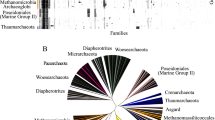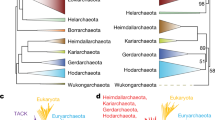Abstract
The available sequences of genes encoding the enzymes associated with histidine biosynthesis suggest that this is an ancient metabolic pathway that was assembled prior to the diversification of Bacteria, Archaea, and Eucarya. Paralogous duplication, gene elongation, and fusion events of several different his genes have played a major role in shaping this biosynthetic route. We have analyzed the structure and organization of histidine biosynthetic genes from 55 complete archaeal genomes and combined it with phylogenetic inference in order to investigate the mechanisms responsible for the assembly of the his pathway and the origin of his operons. We show that a wide variety of different organizations of his genes exists in Archaea and that some his genes or entire his (sub-)operons have been likely transferred horizontally between Archaea and Bacteria. However, we show that, in most Archaea, his genes are monofunctional (except for hisD) and scattered throughout the genome, suggesting that his operons might have been assembled multiple times during evolution and that in some cases they are the result of recent evolutionary events. An evolutionary model for the structure and organization of his genes in LUCA is proposed.





Similar content being viewed by others
Abbreviations
- HisG:
-
ATP phosphoribosyl transferase (EC 2.4.2.17)
- HisD:
-
Histidinol dehydrogenase (EC 1.1.1.23)
- HisC:
-
Histidinol-phosphate aminotransferase (EC 2.6.1.9)
- HisN:
-
Histidinol-phosphate phosphatase (EC 3.1.3.15)
- HisB:
-
Imidazoleglycerol-phosphate dehydratase (EC 4.2.1.19)
- HisH:
-
G-type glutamine amidotransferase
- HisA:
-
[N-(5_-phosphoribosyl) formimino]-5-aminoimidazole-4-carboxamide ribonucleotide isomerase (EC 5.3.1.16)
- HisF:
-
Imidazole glycerol phosphate synthase subunit HisF (EC 4.1.3.-)
- HisI:
-
Phosphoribosyl-AMP cyclohydrolase (EC 3.5.4.19)
- HisE:
-
Phosphoribosyl-ATP pyrophosphatase (EC 3.6.1.31)
- LUCA:
-
Last universal common ancestor
- HGT:
-
Horizontal gene transfer
- PRFAR:
-
N-(5′phospho-d-1′-ribulosylformimino)-5-amino-1-(5-phosphoribosyl)-4-imidazolecarboxamide
- AICAR:
-
5-Aminoimidazole-4-carboxamide ribonucleoside
References
Alifano P, Fani R, Liò P, Lazcano A, Bazzicalupo M, Carlomagno MS, Bruni CB (1996) Histidine biosynthetic pathway and genes: structure, regulation, and evolution. Microbiol Rev 60:44–69
Bovee M, Champagne K, Demeler B, Francklyn C (2002) The quaternary structure of the HisZ-HisG N-1-(5′-phosphoribosyl)-ATP transferase from Lactococcus lactis. Biochemistry 41:11838–11846
Brenner M, Ames B (1971) The histidine operon and its regulation. In: Vogel H (ed) Metabolic pathways. Academic Press, New York, pp 349–387
Brilli M, Fani R (2004) Molecular evolution of hisB genes. J Mol Evol 58:225–237
Brochier-Armanet C, Boussau B, Gribaldo S, Forterre P (2008) Mesophilic Crenarchaeota: proposal for a third archaeal phylum, the Thaumarchaeota. Nat Rev Microbiol 6:245–252
Carlomagno M, Chiarotti L, Alifano P, Nappo A, Bruni C (1988) Structure of the Salmonella typhimurium and Escherichia coli K-12 histidine operons. J Mol Biol 203:585–606
Dandekar T, Snel B, Huynen M, Bork P (1998) Conservation of gene order: a fingerprint of proteins that physically interact. Trends Biochem Sci 23:324–328
Donahue T, Farabaugh P, Fink G (1982) The nucleotide sequence of the His4 region of yeast. Gene 18:47–59
Edgar RC (2004) MUSCLE: a multiple sequence alignment method with reduced time and space complexity. BMC Bioinformatics 5:113
Fani R (2004) Gene duplication and gene loading. In: Miller RV, Day MJ (eds) Microbial evolution: gene establishment, survival, and exchange. ASM Press, Washington, pp 67–81
Fani R, Fondi M (2009) Origin and evolution of metabolic pathways. Phys Life Rev 6:23–52
Fani R, Liò P, Chiarelli I, Bazzicalupo M (1994) The evolution of the histidine biosynthetic genes in prokaryotes: a common ancestor for the hisA and hisF genes. J Mol Evol 38:489–495
Fani R, Liò P, Lazcano A (1995) Molecular evolution of the histidine biosynthetic pathway. J Mol Evol 41:760–774
Fani R, Mori E, Tamburini E, Lazcano A (1998) Evolution of the structure and chromosomal distribution of histidine biosynthetic genes. Orig Life Evol Biosph 28:555–570
Fani R, Brilli M, Liò P (2005) The origin and evolution of operons: the piecewise building of the proteobacterial histidine operon. J Mol Evol 60:378–390
Fani R, Brilli M, Fondi M, Liò P (2007) The role of gene fusions in the evolution of metabolic pathways: the histidine biosynthesis case. BMC Evol Biol 7(Suppl 2):S4
Fondi M, Emiliani G, Fani R (2009) Origin and evolution of operons and metabolic pathways. Res Microbiol. doi: 10.1016/j.resmic.2009.05.001
Glansdorff N (1999) On the origin of operons and their possible role in evolution toward thermophily. J Mol Evol 49:432–438
Guindon S, Gascuel O (2003) A simple, fast, and accurate algorithm to estimate large phylogenies by maximum likelihood. Syst Biol 52:696–704
Horowitz NH (1945) On the evolution of biochemical syntheses. Proc Natl Acad Sci USA 31:153–157
Horowitz NH (1965) The evolution of biochemical syntheses—retrospect and prospect. Academic Press, New York
Itoh T, Takemoto K, Mori H, Gojobori T (1999) Evolutionary instability of operon structures disclosed by sequence comparisons of complete microbial genomes. Mol Biol Evol 16:332–346
Jensen RA (1976) Enzyme recruitment in evolution of new function. Annu Rev Microbiol 30:409–425
Kleeman J, Parsons S (1977) Inhibition of histidyl-tRNA-adenosine triphosphate phosphoribosyltransferase complex formation by histidine and by guanosine tetraphosphate. Proc Natl Acad Sci USA 74:1535–1537
Klemm T, Davisson V (1993) Imidazole glycerol phosphate synthase: the glutamine amidotransferase in histidine biosynthesis. Biochemistry 32:5177–5186
Kuenzler M, Balmelli T, Egli C, Paravicini G, Braus G (1993) Cloning, primary structure, and regulation of the HIS7 gene encoding a bifunctional glutamine amidotransferase: cyclase from Saccharomyces cerevisiae. J Bacteriol 175:5548–5558
Lawrence J (1999) Gene transfer, speciation, and the evolution of bacterial genomes. Curr Opin Microbiol 2:519–523
Lawrence JG, Roth JR (1996) Selfish operons: horizontal transfer may drive the evolution of gene clusters. Genetics 143:1843–1860
Lazcano A, Fox G, Orò J (1992) Life before DNA: the origin and evolution of early Archean cells. In: Mortlock R, Gallo M (eds) The evolution of metabolic functions. CRC Press, Boca Raton, pp 1–13
Lohkamp B, McDermott G, Campbell S, Coggins J, Lapthorn A (2004) The structure of Escherichia coli ATP-phosphoribosyltransferase: identification of substrate binding sites and mode of AMP inhibition. J Mol Biol 336:131–144
Maurel M, Ninio J (1987) Catalysis by a prebiotic nucleotide analog of histidine. Biochimie 69:551–553
Pal C, Hurst LD (2004) Evidence against the selfish operon theory. Trends Genet 20:232–234
Price M, Alm L, Arkin A (2006) The histidine operon is ancient. J Mol Evol 62:807–808
Shen C, Lazcano A, Oró J (1990a) The enhancement activities of histidyl-histidine in some prebiotic reactions. J Mol Biol 31:445–452
Shen C, Mills T, Oró J (1990b) Prebiotic synthesis of histidyl-histidine. J Mol Biol 31:175–179
Shen C, Yang L, Miller S, Oró J (1990c) Prebiotic synthesis of histidine. J Mol Biol 31:167–174
Sissler M, Delorme C, Bond J, Ehrlich S, Renault P, Francklyn C (1999) An aminoacyl-tRNA synthetase paralog with a catalytic role in histidine biosynthesis. Proc Natl Acad Sci USA 96:8985–8990
Swain PS (2004) Efficient attenuation of stochasticity in gene expression through post-transcriptional control. J Mol Biol 344:965–976
Vega M, Zou P, Fernandez F, Murphy G, Sterner R, Popov A, Wilmanns M (2005) Regulation of the hetero-octameric ATP phosphoribosyl transferase complex from Thermotoga maritima by a tRNA synthetase-like subunit. Mol Microbiol 55:675–686
Weber A, Miller S (1981) Reasons for the occurrence of the twenty coded protein amino acids. J Mol Evol 17:273–284
White H (1976) Coenzymes as fossils of an earlier metabolic state. J Mol Evol 7:101–117
White D, Erickson J (1980) Catalysis of peptide bond formation by histidyl-histidine in a fluctuating clay environment. J Mol Biol 16:279–290
Winkler M (1987) Biosynthesis of histidine. In: Neidhardt F, Ingraham J, Low K, Magasanik B, Schaechter M, Humbarger H (eds) Escherichia coli and Salmonella typhimurium: cellular and molecular biology. American Society for Microbiology, Washington, pp 395–411
Woese C (1998) The universal ancestor. Proc Natl Acad Sci USA 95:6854–6859
Ycas M (1974) On earlier states of the biochemical system. J Theor Biol 44:145–160
Author information
Authors and Affiliations
Corresponding author
Rights and permissions
About this article
Cite this article
Fondi, M., Emiliani, G., Liò, P. et al. The Evolution of Histidine Biosynthesis in Archaea: Insights into the his Genes Structure and Organization in LUCA. J Mol Evol 69, 512–526 (2009). https://doi.org/10.1007/s00239-009-9286-6
Received:
Accepted:
Published:
Issue Date:
DOI: https://doi.org/10.1007/s00239-009-9286-6




